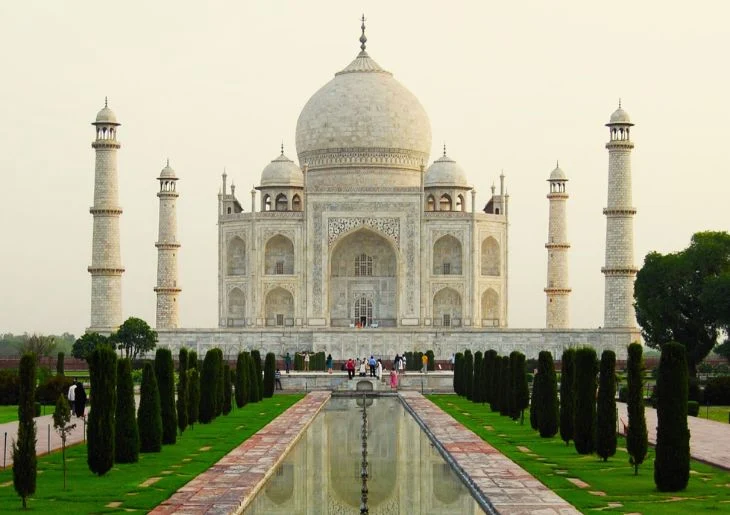What is the Taj Mahal?
The Taj Mahal is an ivory-white marble mausoleum on the south bank of the Yamuna river in the Indian city of Agra. It was commissioned in 1632 by the Mughal emperor, Shah Jahan (reigned from 1628 to 1658), to house the tomb of his favorite wife, Mumtaz Mahal. It is also the final resting place of Shah Jahan himself.
Where is the Taj Mahal located?
The Taj Mahal is located in Agra, India, which is about 200 kilometers south of Delhi.
Why is the Taj Mahal famous?
The Taj Mahal is famous for its stunning beauty and architecture. It is widely recognized as "the jewel of Muslim art in India and one of the universally admired masterpieces of the world's heritage." The Taj Mahal is a UNESCO World Heritage Site and one of the most popular tourist destinations in India.
History of the Taj Mahal
The construction of the Taj Mahal:
The construction of the Taj Mahal began in 1632 and was completed in 1653. It is estimated that over 20,000 workers were involved in the construction of the Taj Mahal.
The Mughal emperor Shah Jahan:
Shah Jahan was the fifth Mughal emperor of India. He was a great patron of the arts and architecture. The Taj Mahal is just one of many beautiful buildings that Shah Jahan commissioned during his reign.
Mumtaz Mahal:
Mumtaz Mahal was Shah Jahan's third wife and his favorite consort. She died in childbirth in 1631. Shah Jahan was so heartbroken by her death that he vowed to build her the most beautiful tomb in the world.
The symbolism of the Taj Mahal:
The Taj Mahal is often seen as a symbol of love and devotion. It is also a testament to the skill and craftsmanship of the Mughal artisans. The Taj Mahal is one of the most iconic buildings in the world and a must-see for anyone visiting India.
Architecture of the Taj Mahal
The design of the Taj Mahal:
The Taj Mahal is a stunning example of Mughal architecture, which is a blend of Persian, Indian, and Islamic influences. The building is made of white marble and is decorated with intricate carvings and mosaics.
Materials and construction techniques:
The Taj Mahal is made of white marble from Makrana, Rajasthan. The marble was transported to Agra on a fleet of over 1,000 elephants. The Taj Mahal was built using a variety of construction techniques, including brick masonry, pietra dura, and calligraphy.
The Taj Mahal complex:
The Taj Mahal complex includes the main mausoleum, a mosque, a mehmankhana (guest house), and a garden. The complex is surrounded by a high wall and is accessed through a grand gateway.
Interesting facts about the Taj Mahal
1. The cost of building the Taj Mahal:
The cost of building the Taj Mahal is estimated to have been around 32 million rupees, which is equivalent to over $1 billion in today's dollars.
2. The labor force involved in building the Taj Mahal:
It is estimated that over 20,000 workers were involved in the construction of the Taj Mahal. The workers came from all over India and Central Asia.
3. Hidden secrets of the Taj Mahal:
The Taj Mahal is full of hidden secrets. For example, the tombs of Shah Jahan and Mumtaz Mahal are actually located in a crypt below the main mausoleum. The tombs are surrounded by a black marble screen that is decorated with precious stones.
The Taj Mahal today:
The Taj Mahal is one of the most popular tourist destinations in India. It is visited by millions of people each year. The Taj Mahal is also a UNESCO World Heritage Site and is protected by the Indian government.
Planning your visit
When to visit the Taj Mahal:
The best time to visit the Taj Mahal is during the winter months (October to March) when the weather is mild and sunny. The Taj Mahal is open from sunrise to sunset, but it is best to visit early in the morning or late in the evening to avoid the crowds.
How to get to the Taj Mahal:
The Taj Mahal is located in Agra, India, which is about 200 kilometers south of Delhi. The easiest way to get to Agra is by train. There are several trains that depart from Delhi daily and the journey takes about 3 hours. You can also fly to Agra from Delhi. The flight takes about 45 minutes.
Where to stay near the Taj Mahal:
There are many hotels and guesthouses located near the Taj Mahal. If you are on a budget, you can stay in one of the many guesthouses. If you are looking for something more comfortable, you can stay in one of the many hotels.
What to wear when visiting the Taj Mahal:
The Taj Mahal is a Muslim shrine, so it is important to dress respectfully. Women should cover their shoulders and knees. Men should wear long pants.
Tips for planning your visit:
- Book your tickets in advance, especially if you are visiting during the peak season.
- Arrive early in the morning or late in the evening to avoid the crowds.
- Wear comfortable shoes, as you will be doing a lot of walking.
- Bring sunscreen, sunglasses, and a hat to protect yourself from the sun.
- Be respectful of the Muslim shrine and dress appropriately.
Exploring the Taj Mahal
The Taj Mahal is a complex of buildings, including the main mausoleum, a mosque, a mehmankhana (guest house), and a garden. Each section of the complex is unique and offers its own insights into the Mughal culture and architecture.
The main courtyard:
The main courtyard is the largest open space in the Taj Mahal complex. It is surrounded by the four main buildings: the mausoleum, the mosque, the mehmankhana, and the gateway. The courtyard is also home to a number of fountains and pools.
The tomb of Mumtaz Mahal:
The tomb of Mumtaz Mahal is the central focus of the Taj Mahal complex. It is a white marble mausoleum that is decorated with intricate carvings and mosaics. The tomb is located on a raised platform in the center of the main courtyard.
The tomb of Shah Jahan:
The tomb of Shah Jahan is located opposite the tomb of Mumtaz Mahal in the main courtyard. It is identical in design to the tomb of Mumtaz Mahal, but it is slightly larger.
The mosque:
The mosque is located on the north side of the main courtyard. It is a white marble building with three domes. The mosque can accommodate up to 25,000 worshippers.
The mehmankhana:
The mehmankhana is located on the south side of the main courtyard. It is a white marble building that was used to accommodate guests of the Taj Mahal. The mehmankhana is now a museum that houses a collection of artifacts from the Mughal period.
The gardens:
The gardens of the Taj Mahal are located on the east and west sides of the main courtyard. The gardens are divided into four quadrants and are planted with a variety of flowers and trees. The gardens are also home to a number of fountains and pools.
Things to do near the Taj Mahal
The Taj Mahal is one of the most iconic buildings in the world, and it is no surprise that it attracts millions of visitors each year. However, there is more to Agra than just the Taj Mahal. There are a number of other things to see and do in the area, including:
Agra Fort:
Agra Fort is a UNESCO World Heritage Site that is located about 2 kilometers from the Taj Mahal. The fort was built by the Mughal emperor Akbar in the 16th century and was used as the imperial residence until the 18th century. The fort is a complex of palaces, mosques, and gardens. Some of the most popular attractions in the fort include the Pearl Mosque, the Jasmine Tower, and the Diwan-i-Am (Hall of Public Audience).
Itmad-ud-Daulah's Tomb (Baby Taj):
Itmad-ud-Daulah's Tomb is a white marble mausoleum that is located about 5 kilometers from the Taj Mahal. The tomb was built in the 17th century and is considered to be a forerunner of the Taj Mahal. The tomb is made of white marble and is decorated with intricate carvings. The interior of the tomb is also decorated with intricate carvings and mosaics.
Mehtab Bagh:
Mehtab Bagh is a garden that is located on the opposite bank of the Yamuna River from the Taj Mahal. The garden offers stunning views of the Taj Mahal and is a great place to watch the sunset. Mehtab Bagh is also a popular spot for birdwatching.
Akbar's Tomb:
Akbar's Tomb is a red sandstone mausoleum that is located about 10 kilometers from the Taj Mahal. The tomb was built in the 17th century and is the burial place of the Mughal emperor Akbar. The tomb is a complex of buildings that includes the tomb chamber, a mosque, and a caravanserai.
Fatehpur Sikri:
Fatehpur Sikri is a deserted city that is located about 37 kilometers from the Taj Mahal. The city was built by the Mughal emperor Akbar in the 16th century and was used as the imperial residence for about 15 years. Fatehpur Sikri is a UNESCO World Heritage Site and is a popular tourist destination. Some of the most popular attractions in Fatehpur Sikri include the Jama Masjid, the Buland Darwaza, and the Panch Mahal.
These are just a few of the many things to see and do near the Taj Mahal. With its rich history and culture, Agra is a city that has something to offer everyone.
Conclusion
Why is the Taj Mahal a must-see destination?
The Taj Mahal is a must-see destination for a number of reasons. First, it is one of the most beautiful buildings in the world. The white marble mausoleum is decorated with intricate carvings and mosaics, and it is a testament to the skill and craftsmanship of the Mughal artisans.
Second, the Taj Mahal is a symbol of love and devotion. It was built by the Mughal emperor Shah Jahan as a tomb for his beloved wife, Mumtaz Mahal. The Taj Mahal is a reminder of the power of love and the importance of cherishing the people we love.
Third, the Taj Mahal is a UNESCO World Heritage Site. This means that it is recognized as one of the most important cultural and historical sites in the world. The Taj Mahal is a must-see for anyone who is interested in world history and culture.
If you are planning a visit to the Taj Mahal, be sure to check out the other attractions in Agra, such as the Agra Fort, Itmad-ud-Daulah's Tomb, Mehtab Bagh, and Akbar's Tomb. You can also take a day trip to Fatehpur Sikri, which is a deserted city that is located about 37 kilometers from Agra.
Additional tips:
1. Take your time and enjoy the beauty of the Taj Mahal.
2. Don't be afraid to ask questions. The tour guides at the Taj Mahal are very knowledgeable and can help you learn more about the building and its history.
3. Take lots of pictures! The Taj Mahal is a truly photogenic building.


